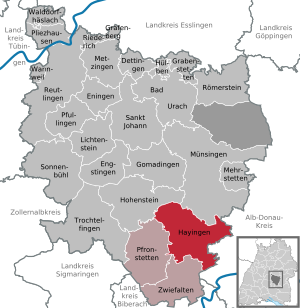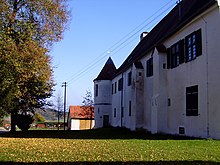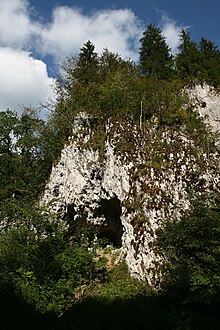Hayingen
| coat of arms | Germany map | |
|---|---|---|

|
Coordinates: 48 ° 17 ' N , 9 ° 29' E |
|
| Basic data | ||
| State : | Baden-Württemberg | |
| Administrative region : | Tübingen | |
| County : | Reutlingen | |
| Height : | 661 m above sea level NHN | |
| Area : | 63.37 km 2 | |
| Residents: | 2203 (December 31, 2018) | |
| Population density : | 35 inhabitants per km 2 | |
| Postal code : | 72534 | |
| Area code : | 07386 | |
| License plate : | RT | |
| Community key : | 08 4 15 034 | |
| LOCODE : | DE HYN | |
| City structure: | 5 districts | |
City administration address : |
Marktstrasse 1 72534 Hayingen |
|
| Website : | ||
| Mayor : | Kevin Dorner | |
| Location of the city of Hayingen in the Reutlingen district | ||
Hayingen is a town in the Reutlingen district in Baden-Württemberg . Hayingen, with a large part of its territory (95.4%), is part of the Swabian Alb biosphere area and a state-approved climatic health resort .
geography
location
Hayingen is located on the Swabian Alb .
Neighboring communities
The following cities and communities border the city of Hayingen, they are named starting in the north in clockwise order and belong to the Reutlingen district or the Alb-Danube district ¹
Münsingen , Ehingen¹ , Emeringen¹ , Zwiefalten , Pfronstetten and Hohenstein .
City structure
Hayingen, with the districts of Anhausen, Ehestetten, Indelhausen, Münzdorf and Oberwilzingen, includes 12 other villages, hamlets and farms in addition to the core town of Hayingen.
See also: List of places in the Reutlingen district
In the urban area there are several abandoned , no longer existing settlements; the Altmannshausen settlement mentioned in 1208 as Altmanshusen and in 1217 as Altmannishusin . Altmannshausen was owned by the Salem monastery and was sold to the stadium in 1329 . In 1437 the place was uninhabited; Bolstetten, mentioned in 817 as Polstetin and in 1208 as Bolstetin , was absorbed in Altmannshausen, as did the 1268 as Horne / Uffenhorn Horn, which at that time was owned by the Salem Monastery. The Weilerfeld, mentioned in 1208 as Wilervelt , and Winden, mentioned in 1282 as oppidum Wineden (all in the district of Anhausen), were also owned by the Salem Monastery ; the two places Ettenheim and the Pflummersbuch mentioned in 1364 as Pflumersbuch in the district of Ehestetten; the Baldenstein homestead, which was sold after 1329, the place Bühlenfingen, and the settlements mentioned around 1100 Leimgrube (as loco Leimgrube ), Maisinhart (as Maisinhart ), Schlechtenbuch (as Slehtinbuch ), Wildsberg (as Wildisberc ), the Steinhausen ( Stünhuser Feld ) mentioned in 1523 and the 1208 Vainhusen place indicated Vainhausen. Vainhausen was owned by the Heiligkreuztal monastery , later owned by the Zwiefalten monastery and was sold in the 15th century (all in the Hayingen district).
To the north of Münzdorf are the remains of the Weiler summit castle .
climate
Hayingen is a climatic health resort on the Swabian Alb.
history
Early history
On the occasion of an exchange of goods in 785, Hayingen was first mentioned with Heinger marca (district Hayingen) in the Lorsch Codex . The knight Swigger von Gundelfingen probably founded the city in 1276. Due to the Reichsdeputation Hauptschluss , Hayingen came to the Kingdom of Württemberg from the Principality of Fürstenberg as part of the mediatization .
Administrative affiliation
The city belonged to the Oberamt Münsingen . In the administrative reforms during the Nazi era in Württemberg in 1934 the supreme office was renamed in district Münsingen and 1938 the district Münsingen reshaped. After the Second World War, the city of Hayingen fell into the French zone of occupation and thus came to the newly founded state of Württemberg-Hohenzollern in 1947 , which was incorporated into the state of Baden-Württemberg in 1952. After the dissolution of the Münsingen district as part of the district reform , Hayingen was added to the Reutlingen district in 1973 .
Population development
The population figures are census results (¹) or official updates from the State Statistical Office ( main residences only ).
|
|
Religions
Due to the fact that the city was part of the Fürstenberg estates, Hayingen remained Catholic even after the Reformation . There are still four Roman Catholic churches that belong to the Reutlingen-Zwiefalten deanery .
After the transition to Württemberg, Protestant residents also moved there in the 19th century. In 1884, a branch community of Zwiefalten was founded in Hayingen, whose services were initially held in a prayer room in the old fruit box on Karlsplatz. After the Second World War, the community grew rapidly. The Protestant residents of the Haying district of Ehestetten belonged to the parish of Dapfen until 1983. With effect from December 1, 1983, they were reclassified to the Hayingen parish. The current Protestant parish of Hayingen thus includes the town of Hayingen and the Haying district of Ehestetten. It is merged with the Protestant parish of Zwiefalten to form the Evangelical General Parish of Zwiefalten-Hayingen .
politics
Municipal council
The local council in Hayingen has 14 members. The municipal council consists of the elected voluntary councilors and the mayor with voting rights as chairman. The local elections on May 25, 2014 , with voter turnout of 73.00% (2009: 72.71%), led to the following official final result.
| Free Voter Association (FWV) | 40.9% | 6 seats | (2009: 38.1%, 5 seats) |
| Christian Democratic Union of Germany (CDU) | 39.1% | 5 seats | (2009: 36.2%, 5 seats) |
| New list of citizens (NB) | 20.0% | 3 seats | (2009: 25.7%, 4 seats) |
mayor
The mayor is elected for a term of 8 years.
- 1953-1975: Paul Burger
- 1975–2015: Robert Riehle
- since May 2015: Kevin Dorner
coat of arms
Blazon : "In blue over a silver crenellated wall rising from the lower edge, on both sides with a red-roofed silver tower , a golden shield with a chipped red sloping beam ."
The coats of arms of the former municipalities
The city consists of Hayingen and the districts that were added during the municipal reform (with their coats of arms):
 Anhausen |
 Marriage |
 Indelhausen |
 Münzdorf |
|---|
Culture and sights
Hayingen is located on the Swabian Alb Südrand-Weg , a long-distance hiking trail of the Swabian Alb Association .
theatre
The Naturtheater Hayingen is an open-air stage with covered auditoriums, where mainly plays are performed in the Swabian dialect. Over a million visitors have visited the Swabian nature theater since it was founded in 1949. The seasons are from July to September annually.
societies
Due to its structure in many districts, Hayingen has a rich club life, which includes sports clubs such as the Luftsportverein Hayingen, TC Hayingen, TSV Hayingen and SV Ehestetten-Münzdorf as well as fools' guilds and youth clubs such as Bauwagen Hayingen e. V., the Landjugend Hayinger youth club, the youth club Ehestetten e. V. or the youth club PUG e. V. of the districts of Indelhausen and Anhausen. In addition to the church choirs, the city's musical life is shaped by the Hayingen song wreath with its Hay-Fidelity choir, the Hayingen town band, the men's choir and the Ehestetten music club, and the Münzdorf choir.
Buildings
The city of Hayingen has a number of medieval buildings in the city center , including the Alte Spital , built in 1536 , which is one of the oldest buildings in the city. The cap tower is a popular photo opportunity and a still preserved part of the former city wall. The town church of St. Vitus in the town center from the 13th century now has a baroque appearance.
The historic buildings in the districts include the town hall and the beneficiary's house in Indelhausen from the 16th century and the castle in Ehestetten.
Evangelical Katharinenkirche
The small church of the Evangelical Parish of Hayingen is located at the end of the village in the direction of Indelhausen, at the junction to the nature theater. The oldest part of the church is the choir, an old field chapel dedicated to Catherine of Alexandria from the 15th century. This chapel, which was secularized in the last century, was donated to the Evangelical Church in Hayingen by the city of Hayingen in 1953. In 1953/54 the chapel was enlarged by the Stuttgart architect Walter Ruff by adding a nave with a sacristy to a church with around 120 seats. The sculptor Emil Jo Homolka (Königsfeld / Black Forest; 1925–2010) created the crucifix in 1954, the artist Rudolf Yelin the Elder. J. the four small round choir windows as models in faith : Martin of Tours , Archangel Michael (the dragon slayer), Christophorus and Catherine of Alexandria.
Castles
Many castles settled along the old trade route in Lautertal, but only a few have been completely preserved. Are among others, the 1350 built on Hayinger city castle Derneck in the district Münzdorf that serves as a youth hostel, which in 1100 built Münzdorfer castle ruins hamlet that is only recognizable as a castle site that was built before 1258 Ruin Monsberg that strongly preserved ruins Schuelzburg from the 12th century, the Wartstein ruin from before 1185, the keep of which today serves as a lookout tower over the Lautertal, and the Maisenburg ruin from the 12th century, whose adjoining estate is still preserved. The Alt-Hayingen Castle, also located above the Lautertal in the vicinity of the Maisenburg and Schülzenburg, is an early Celtic rampart from around 400 BC. Outside the Lautertal lies the Alt-Ehrenfels castle ruins .
Natural monuments
- Bear cave in the Glastal
- Bettelmannshöhle in Lautertal
- Gerber cave, district of Anhausen
- Wimsener Höhle , also called Friedrichshöhle, a water cave accessible by boat
- Digelfeld nature reserve , with 121 hectares the largest juniper heath in the Swabian Alb , near Hayingen
Regular events
- City festival with arts and crafts market, mid-July
- Hayingen Nature Theater, beginning of July to beginning of September
Economy and Infrastructure
traffic
The state road 245 connects the city with Zwiefalten and thus with the federal road 312 . The L 249 connects the city with Obermarchtal and thus with the B 311 .
The Public transport is by the Verkehrsverbund Neckar-Alb-Donau guaranteed (NALDO). The city is in honeycomb 228.
education
In Hayingen there is a primary school with the Digelfeldschule. A primary school existed in the Ehestetten district until 2009.
Personalities
Honorary citizen
- Albert Stemmer (1856–1946), postal director
- Johannes Schwendele (1883–?), City pastor, city cameraman and episcopal commissioner as well as namesake of the local Johannes-Schwendele-Weg
- Gustav Jourdan (1884–1950), artist and university professor, co-founder of nature theater and namesake of the local Gustav Jourdan path
- Gustav Wahl, senior councilor
- Robert Riehle, former mayor
sons and daughters of the town
- Franz Sales Hechinger (1800–1887), organ builder
- Josef Rapp (1832–1896), chief architect and member of the state parliament
- Karl Speth von Schülzburg (1844–1905), member of the state parliament, majorate, district judge and chamberlain
- Martin Schleker (* 1935), actor and writer
Other personalities
- Georg Anton Bredelin (1752–1814), poet and composer, was a teacher in Hayingen
- Gotthold Brendle (1892–1963), politician (CDU)
- Tiberius Fundel (1897–1982), politician (CDU)
- Simon Tress (* 1983), cook
literature
- Johannes Schwendele: History of the city and the parish of Hayingen: popular presentation of the local history, built up and compiled on the results of scientific research. Schwabenverlag, Riedlingen 1958 (secondary title: Ortschronik Hayingen)
Web links
- ditto from Anhausen , Ehestetten , Indelhausen and Münzdorf .
- Official website of the city
Individual evidence
- ↑ State Statistical Office Baden-Württemberg - Population by nationality and gender on December 31, 2018 (CSV file) ( help on this ).
- ^ The state of Baden-Württemberg. Official description by district and municipality. Volume VII: Tübingen administrative region. Kohlhammer, Stuttgart 1978, ISBN 3-17-004807-4 . Pp. 93-96
- ↑ Minst, Karl Josef [transl.]: Lorscher Codex (Volume 5), Certificate 3225, October 9, 785 - Reg. 1947. In: Heidelberg historical stocks - digital. Heidelberg University Library, p. 123 , accessed on April 22, 2018 .
- ^ Website of the Evangelical Church Community in Hayingen
- ^ Website of the Evangelical Church Community in Zwiefalten
- ↑ Municipal election committee : Announcement of the election results from April 26, 1953.
- ↑ Hayingen: The mayor disembarks swp.de, accessed on May 14, 2015
- ↑ Mayor election Hayingen gea.de, accessed on March 9, 2015
- ↑ Adolf Gommel (ed.): Ev. Contemporary Church Art - Festschrift of the Association for Christian Art in the Evangelical Church of Württemberg to celebrate the 100th anniversary 1857-1957 ; Stuttgart 1957, Fig. 24 f
- ^ Claudia Lamprecht: Rudolf Yelin (1902–1991): catalog raisonné of the building-related works ; o. O. (Stuttgart), o. J. (1991), p. 39
- ↑ 216594 Hayingen: Honorary Citizenship Certificate and La-Ola-Welle ( page can no longer be accessed , search in web archives ) Info: The link was automatically marked as defective. Please check the link according to the instructions and then remove this notice. swp.de, accessed on May 14, 2015












